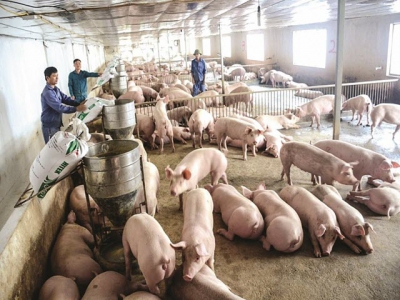Price of pigs falls too deeply, millions of breeders to face difficulties

From now to the end of the year, the Ministry of Agriculture and Rural Development is expecting to maintain the price of live pigs at about VND70,000 per kg. If the price falls too deeply, millions of small-scale breeders will face difficulties.
According to the Ministry of Agriculture and Rural Development, in the last days of September 2020, the average price of live pigs ranged from VND75,000-81,000 per kg, down VND19,000-25,000 per kg compared to the highest period.
Answering questions from Customs Newspaper at the third quarterly press conference of the Ministry of Agriculture and Rural Development on October 6, Mr. Nguyen Xuan Duong, Acting Director of the Department of Livestock Production (MARD) said, at present , the live pig price has returned to VND70,000 - 75,000 VND per kg, even only VND69,000 per kg in some areas. It is expected that from now to the end of the year, it will stay at VND70,000 per kg.
Some say this price is still too high. However, Deputy Minister of Agriculture and TPTN Phung Duc Tien said that African swine fever has basically been controlled, pig herds have gradually recovered but repopulation is still slow.
The price of pig breeds has been continuously at a high level since the beginning of the year (about VND2.5-3 million per head), so the repopulation is mainly concentrated in large farms and farming costs are also high.
"For concentrated farming, the cost is VND50,000 per kg. The cost of small-scale farming is VND71,000 per kg. If now the pig price is reduced, millions of households will face difficulties," Deputy Minister Phung Duc Tien said.
The Ministry of Agriculture and Rural Development recently sent to the Prime Minister a report on the performance results of the agricultural sector in the first nine months of 2020, which clearly states the issue of pork demand-supply.
Specifically, according to data from localities, there are currently about 25.5 million pigs (including piglets), equivalent to 82% compared to the time before the African swine fever epidemic. The localities are making efforts for repopulation.
In regions, the repopulation as of September, 2020 in the Southeast gained the highest rate of over 100%; the lowest one was in the Mekong Delta with 60.9%; this rate in the Central Highlands reached 96%; North and South Central Coast 93.9%; the Northern Midlands and Mountains 80.2% and the Red River Delta 68%.
Pig herds by the end of September 2020 were estimated to increase by 3.6% over the same period last year, the output of fresh pork was about 2.5 million tons, equaling 96.8% over the same period last year.
Regarding imports, the representative of the Ministry of Agriculture and Rural Development said that the amount of imported pork (both fresh and frozen pork) was equal to 156,000 tons so far, only accounting for 4.3% of the demand output of 3.8 million tons per year.
Mr. Phung Duc Tien also said the Government and the Prime Minister have instructed the Ministry of Agriculture and Rural Development and other ministries and agencies to continue to direct and control the implementation of synchronous solutions for epidemic prevention on the basis of complying with market principles and legal regulations.
At the same time, to continue repopulation and maintaining of production to ensure enough pork supply for consumers.
With the current repopulation rate, Mr. Nguyen Xuan Duong said: "The supply of pork in the fourth quarter and the Lunar New Year 2021 will be ensured.”
Currently, many localities have the repopulation rate of over 100%, an average of 118.3% compared to the time before the African swine fever epidemic (December 2018). In which, Binh Phuoc ranked first with 164.7%; followed by BinhDinh, Kon Tum, Dac Nong, Quang Ngai, NinhThuan; Yen Bai; HoaBinh; Tay Ninh; Son La; Lam Dong andKhanhHoa.
Group 2 has the repopulation rate from 90% to less than 100%, an average of 94.3% compared to December 31, 2018, including nine provinces: BinhThuan; Gia Lai; Quang Binh; Thanh Hoa; Phu Yen;Binh Duong; Dak Lak; Ha Giang and Can Tho.
Group 3 has the repopulation rate from 70% to less than 90%, an average of 81.0% compared to December 31, 2018, including 20 provinces and cities: Tuyen Quang; Nghe An; Hung Yen; Nam Dinh; Dong Nai; Bac Giang; Thai Nguyen; Lao Cai; Ha Tinh; Ca Mau; Tra Vinh; Ba Ria Vung Tau; Dien Bien; Ha Nam; Hue; Bac Kan; Phu-Tho; Cao Bang; Bac Lieu and Lai Chau.
Group 4 consists of 22 provinces and cities with the repopulation rate of less than 70%, an average rate of 55.5% compared to December 31, 2018, namely: Bac Ninh; Thai Binh; Hanoi; Vinh Long; Dong Thap Quang Tri; Quang Nam; KienGiang; Tien Giang; Vinh Phuc; HauGiang; NinhBinh; Soc Trang; Long An; Hai Duong; Quang Ninh; Ben tre; HCMC; AnGiang; Hai Phong; Da Nang City and Lang Son.
Related news
 Vietnamese co-operatives export dragon fruit, pomelo to Canada
Vietnamese co-operatives export dragon fruit, pomelo to Canada Thanh Bình Co-operative’s dragon fruit and Bến Tre Green Pomelo Cooperative’s pink lady pomelo have hit shelves at supermarkets and fruit shops and a juice
 Ho Chi Minh City pilot to build temporary structures on agricultural land
Ho Chi Minh City pilot to build temporary structures on agricultural land The Ho Chi Minh City People’s Committee has launched a pilot programme to build temporary structures on agricultural land in Củ Chi, Cần Giờ and Nhà Bè district
 Đồng Tháp holds ceremony for first advanced rice farming project
Đồng Tháp holds ceremony for first advanced rice farming project The Đồng Tháp Province People’s Committee on Wednesday held a ceremony to celebrate the Mekong Delta province’s first advanced rice farming project